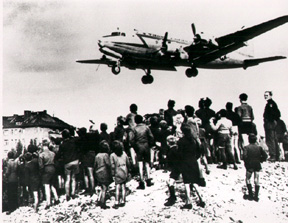A Reservist Flies the Berlin Airlift
September turned into October. The C-47s were withdrawn by the Americans from airlift service because of their slower air speeds and modest carrying capacity, to be replaced by the faster C-54s with their ability to lift ten tons. The British, however, retained use of their Dakotas throughout the airlift months, flying from several RAF bases in western Germany to Gatow, the second major airfield in Berlin. The 313th Troop Carrier Group moved north with its C-54s, known as Skymasters, to Fassberg in the British occupation zone, from which the run to Berlin was considerably shorter than that from Frankfurt. Many of us from the 60th, our C-47 days at an abrupt end, were sent to Fassberg and to the 313th to transition to the C-54s. At this erstwhile Luftwaffe technical training base, now an RAF station, I was posted to the 29th Troop Carrier Squadron of the group and commenced to fly fast and furiously on missions to Berlin. The Skymaster was a dream, as easy to fly as a Piper Cub. Frank and I became roommates and flying partners, and although he ultimately served 28 years on active duty, retiring as a colonel; while I returned to civilian life and pursued an academic career, we have remained through all the years since then close friends. Frank and I quickly befriended several Brits who were supervising displaced persons working as aircraft loaders, and this congenial association helped very much to ease our anxieties over being stationed at an RAF air base where the food staples were tea, Brussels sprouts, and warm beer.
{default}
Berliners watching a C-54 Skymaster land at Tempelhof, Summer 1948.
When a rapidly constructed third Berlin airfield at Tegel in the French sector of the city was ready for use in November, the Fassberg C-54 crews, carrying coal almost exclusively from their base, made that new facility their habitual destination. The days and weeks went by; the missions and the tonnage carried continued to rise. In October, all airlift operations, British and American, were placed under a unified command: the Combined Airlift Task Force. This move proved to be a giant step forward toward airlift effectiveness. By December many procedures–instrument flight rules, pilot certification, missed approach policies, turn-around time in Berlin, and also ground rules such as aircraft loading, unloading, and maintenance–had become nicely standardized, resulting in much improved airlift efficiency. The airlift, since the hasty improvisations of its first few months, by the end of the year would become a well-oiled, precision machine. Air crews now arriving for duty were fresh from the so-called airlift prep school at Great Falls, Montana, where they honed their skills on flight patterns and procedures identical to those on the real airlift. Flying had become routine, almost boring, and certainly tiring. But as Major General William Tunner, the task force commander, emphasized, "There’s nothing glamorous about it; it is this beat, this precise rhythmical cadence, which determines the success of an airlift."

Berlin women loading rubble for use in the construction of Tegel airfield, Autumn 1948.
Cold weather set in, with winter not far behind. Americans and Britons alike at the Fassberg station began to think of the Berliners, especially the children of Berlin, for everyone realized that the airlift aid notwithstanding, they were cold, undernourished, and facing the prospect of a long, harsh winter. The thought of doing something for those children began to crystallize, and several impromptu groups on the air base sent out appeals to various organizations at home for clothing, toys, candy, and other items suitable for Christmas gifts that airlift crews could deliver to Berlin for distribution. One such group, composed of students at Alfred University in western New York, responded to the requests in a burst of enthusiasm remembered as nothing short of miraculous as they set out on a gift procurement and wrapping spree. Led by AU students Charley Clark and Kathy Lacakes, as well as Mary Forrest of the University staff, the quest for childrens’ gifts rallied the students and area merchants to the cause. Imagine everyone’s virtual disbelief and wonderment when in mid-December several hundred gift packages arrived from Alfred in the air base post office! But those packages were just the tip of the iceberg. Other parcels soon arrived from all points of the compass. One enthusiast, the editor of the Nassau Review Star on Long Island, New York gave broad publicity to the requests from Fassberg, with the result that many groups from across the country collected Christmas packages for shipment to Germany. It was truly a common, yet uncoordinated, effort, but in the end it all turned out beautifully. By Christmastime an unbelievable 10,000 gift packages had arrived in Fassberg for delivery to Berlin! Operation Santa Claus was in full force, and many Berlin kinder enjoyed their 1948 Christmas because of it. For many at Fassberg, this was certainly a most memorable and satisfying airlift experience.

